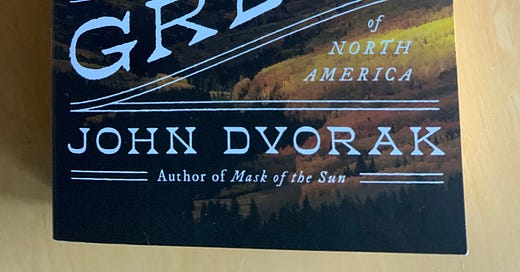When is the last time you thought about the ground we live on? The last hill you climbed or the lake you’re planning to enjoy this summer? Ever bothered to wonder why the Rockies are roughly a thousand miles in from the Pacific, then another series of ranges are 900 miles nearer that huge ocean? No, I didn’t think so nor am I criticising you for that!
We think about the weather as we generally think it should be different. This weekend a couple of you might have had the privilege of seeing the ‘Northern Lights’ all the way south into the Lower 48. So cool but I missed them due to their nearest location several hours drive to the west or north (life is a series of trade offs—being home versus the awe-inspiring view but several hours’ drive).
The planet we live on is actually pretty bloody interesting but it’s also complicated. As some of you know, I spent several years in Colombia where earthquakes were not infrequent. The country suffered a devastating volcanic eruption in November 1985 as well so I have always found these two geological phenomena mildly interesting. I took a couple of geology courses in college but college was years back so I remember odd anecdotes. And it turns out what I studied (insert big number here) years back has been completely reevaluated.
We spent a delicious hour last week at MacIntyre’s Books in Fearington, North Carolina where I came across John Dvorak’s, How the Mountains of North America Grew: A New Geological History (New York: Pegasus Books, 2021). What a gem, pun intended. Not only is it written in an accessible way but it shows the power of questions so clearly in all aspects of life. As the cover quotes the Wall Street Journal, Dvorak explains the lengthy history of the planet so easily.
.
Many of you will recall I wrote only a week ago about science revising its theories because evidence supports or disproves theories. This book illustrates that point on virtually every page. I had no idea how many things I have read over the past half a century that we now know were incorrect and why. Plate techtonics, which all of us may have heard of, only became prominent in my lifetime. I haven’t reached it yet but anticipate he will explain how our knowledge of Yellowstone, a caldera from a supervolcano, evolved relatively recently.
How did they figure these things out? Posing questions (hypotheses) about things, then find manners by which to provide evidence. The hypotheses are often proven false but then the questioning cycle begins anew to answer why. The result is such different understanding, with corroboration, of the geology of the United States.
This book also reminds us we don’t always get answers when we want them. If the evidence is ambivalent, which happens frequently, the question remains open. And that is perfectly fine even if uncomfortable or disappointing to the investigator.
It gradually dawned on me over my teaching career that why was the central question for so much of national security strategy. Not why because I wanted a particular answer but because the evidence on assumptions, context, or actions made it so. But strategy is overwhelmingly about the here and now. Dvorak is writing about as many as 4.51 billion years ago. Same process of why and hypotheses can address the issue of the Morton Gniess west of Minneapois turning out to be the oldest rock outcrop in the United States or why are Netanyahu and Modi threatening seventy-five years of democracy in Israel and India, respectively?
We tend as humans to default to ‘what?’ instead of ‘why?’ because ‘what conversations’ are descriptive and we like feeling we know the right answer. Certainty is always more comforting if incomplete or naive. The ‘why questions’, however, push us to think much further. Dvorak does that in a completely different field making my head hurt, a good thing once in a while. We always need reconsider our assumptions….FIN




